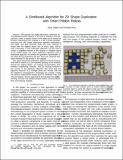| dc.contributor.author | Gilpin, Kyle W. | |
| dc.contributor.author | Rus, Daniela L. | |
| dc.date.accessioned | 2014-10-09T17:54:02Z | |
| dc.date.available | 2014-10-09T17:54:02Z | |
| dc.date.issued | 2012-05 | |
| dc.identifier.isbn | 978-1-4673-1405-3 | |
| dc.identifier.isbn | 978-1-4673-1403-9 | |
| dc.identifier.isbn | 978-1-4673-1578-4 | |
| dc.identifier.isbn | 978-1-4673-1404-6 | |
| dc.identifier.issn | 1050-4729 | |
| dc.identifier.uri | http://hdl.handle.net/1721.1/90842 | |
| dc.description.abstract | We present our digital fabrication technique for manufacturing active objects in 2D from a collection of smart particles. Given a passive model of the object to be formed, we envision submerging this original in a vat of smart particles, executing the new shape duplication algorithm described in this paper, and then brushing aside any extra modules to reveal both the original object and an exact copy, side-by-side. Extensions to the duplication algorithm can be used to create a magnified version of the original or multiple copies of the model object. Our novel duplication algorithm uses a distributed approach to identify the geometric specification of the object being duplicated and then forms the duplicate from spare modules in the vicinity of the original. This paper details the duplication algorithm and the features that make it robust to (1) an imperfect packing of the modules around the original object; (2) missing communication links between neighboring modules; and (3) missing modules in the vicinity of the duplicate object(s). We show that the algorithm requires O(1) storage space per module and that the algorithm exchanges O(n) messages per module. Finally, we present experimental results from 60 hardware trials and 150 simulations. These experiments demonstrate the algorithm working correctly and reliably despite broken communication links and missing modules. | en_US |
| dc.description.sponsorship | United States. Army Research Office (Grant W911NF-08-1-0228) | en_US |
| dc.description.sponsorship | National Science Foundation (U.S.). Office of Emerging Frontiers in Research and Innovation (Grant 0735953) | en_US |
| dc.description.sponsorship | American Society for Engineering Education. National Defense Science and Engineering Graduate Fellowship | en_US |
| dc.language.iso | en_US | |
| dc.publisher | Institute of Electrical and Electronics Engineers (IEEE) | en_US |
| dc.relation.isversionof | http://dx.doi.org/10.1109/ICRA.2012.6225227 | en_US |
| dc.rights | Creative Commons Attribution-Noncommercial-Share Alike | en_US |
| dc.rights.uri | http://creativecommons.org/licenses/by-nc-sa/4.0/ | en_US |
| dc.source | MIT web domain | en_US |
| dc.title | A distributed algorithm for 2D shape duplication with smart pebble robots | en_US |
| dc.type | Article | en_US |
| dc.identifier.citation | Gilpin, Kyle, and Daniela Rus. “A Distributed Algorithm for 2D Shape Duplication with Smart Pebble Robots.” 2012 IEEE International Conference on Robotics and Automation (May 2012). | en_US |
| dc.contributor.department | Massachusetts Institute of Technology. Computer Science and Artificial Intelligence Laboratory | en_US |
| dc.contributor.department | Massachusetts Institute of Technology. School of Engineering | en_US |
| dc.contributor.mitauthor | Gilpin, Kyle W. | en_US |
| dc.contributor.mitauthor | Rus, Daniela L. | en_US |
| dc.relation.journal | Proceedings of the 2012 IEEE International Conference on Robotics and Automation | en_US |
| dc.eprint.version | Author's final manuscript | en_US |
| dc.type.uri | http://purl.org/eprint/type/ConferencePaper | en_US |
| eprint.status | http://purl.org/eprint/status/NonPeerReviewed | en_US |
| dspace.orderedauthors | Gilpin, Kyle; Rus, Daniela | en_US |
| dc.identifier.orcid | https://orcid.org/0000-0001-5473-3566 | |
| dc.identifier.orcid | https://orcid.org/0000-0002-9034-2340 | |
| mit.license | OPEN_ACCESS_POLICY | en_US |
| mit.metadata.status | Complete | |
